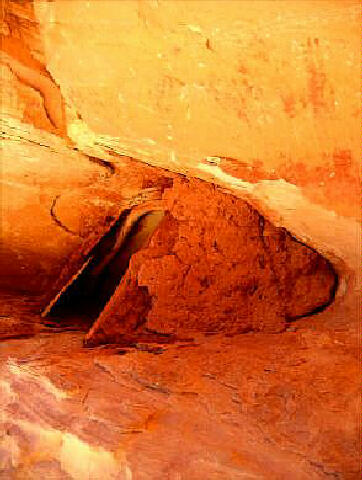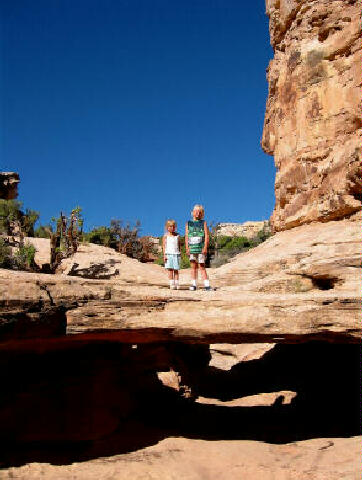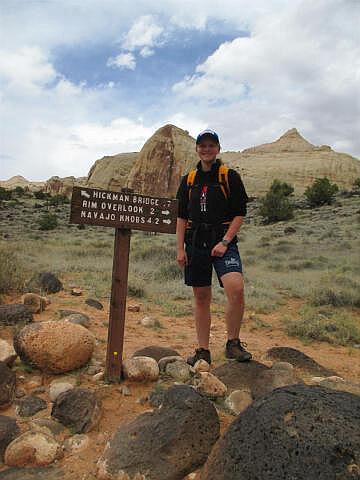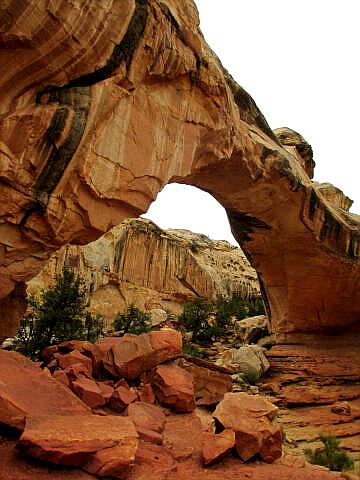[ Homepage
] [ Introduction ] [ Warning ] [ Ratings
] [ Ethics ] [ Feedback ] [ Updates
]
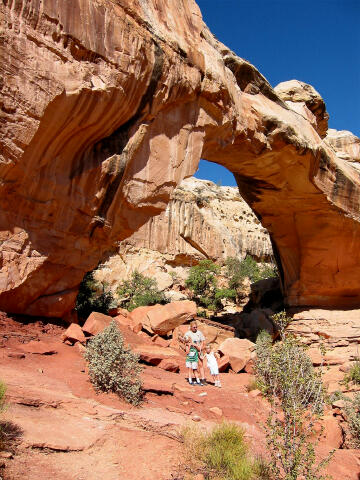 |
Hickman Bridge
Capitol Reef National Park
Hiking
The Hickman Bridge Trail is one of the more popular and perhaps the most
picturesque hike in Capitol Reef. A few hours of well spent time will allow you to get the
feel of the park. You will also be rewarded with remnants of the Fremont Indian culture
and a visit to the most famous rock span in the park.
This hike is
suitable for all healthy adults and children. The entire family will enjoy this wonderful
stroll in Capitol Reef. |
General Information:
  The Hickman Bridge trail is
not difficult and can be completed by any healthy adult or child. No special gear is
required other than footwear suitable for walking over rough ground. The hike involves
walking approximately one mile each way over a well maintained trail with an elevation
gain of 400 feet. The route will require approximately one to two hours round trip to complete.
The Hickman Bridge trail is
not difficult and can be completed by any healthy adult or child. No special gear is
required other than footwear suitable for walking over rough ground. The hike involves
walking approximately one mile each way over a well maintained trail with an elevation
gain of 400 feet. The route will require approximately one to two hours round trip to complete.
Much of the
route is exposed to the sun and there is little shade available. During hot weather an
early morning or evening hike is recommended. Every member of your hiking party should
carry at least one liter of water. This hike should be easily accessible year round.
Along the
route there are eighteen numbered sign posts that are keyed to an interpretive guide
available at the trailhead. I highly suggest that you procure one of these guides. The
knowledge and learning experience is fun for all ages. Children also have a great time
searching for the next sign post which really shortens the hike for them.
Navigation
for this hike is easy. The route is well marked and signed. A GPS is extreme over kill but
I have included the important waypoints for the gizmo junkies. The USGS 7.5' Map titled
"Fruita" covers this hike. You should have no problems completing this hike
using only commonsense and the interpretive trail guide. The
Rim Overlook Trail can be added to this hike
for those wanting to add more adventure or create a longer day.
Trailhead Information:
To reach the
trailhead from the Capitol Reef Visitor Center take Highway 24 east for 2.0 miles to the
signed Hickman Bridge Trailhead located at mile marker 81.1. The trailhead is located on
the north side of Highway 24 just before a bridge over the Fremont River. The trailhead
consists of a large paved parking area, kiosk and a pit toilet. Any vehicle can access this
trailhead and all roads are paved.
Route Information:
From the Hickman Bridge Trailhead (N38° 17' 19", W111° 13'
42"), the trail follows the north bank of the Fremont River downstream a short
distance and than begins to switchback up the Kayenta sandstone. At the top of the
switchbacks you will notice a short trail branching to the right (east). This trail
extends 30-yards to the remnants of a Fremont Culture pit house (N38° 17' 20",
W111° 13' 32"). The pit house foundation is identified by the ring of large black
rocks.
Continuing
hiking up the main trail and you will soon come to a signed junction (N38° 17' 22",
W111° 13' 35"). The right (north) fork is the Rim Overlook Trail. Take the left
(west) fork signed Hickman Bridge. From the junction the trail leads over a small rise and
down into the bottom of an interesting wash.
Several
fascinating items can be found in the wash. Look on the north cliff face about 50 feet
above the trail and you will find a small structure called a granary (N38° 17' 27",
W111° 13' 50"). Fremont people used the granary to store beans and corn grown along
the Fremont River. Approximately 100 yards beyond the granary the trail passes next to the
small Nels Johnson Natural Bridge (N38° 17' 26", W111° 13' 53"). This bridge
was named after one of the earliest homesteaders of the Fruita area.
From the
Nels Johnson Natural Bridge the trail climbs out of the bottom of the wash and up the
south bank. A short distance after exiting the wash bottom the trail forks (N38° 17'
26", W111° 13' 59"). The trail to the left (west) is the return loop. Take the
trail to the right (north) which Leads a short distance to the base of Hickman Natural
Bridge (N38° 17' 29", W111° 14' 4").
Hickman
Natural Bridge is one of the largest rock spans in the park. The bridge has an opening of
125 feet top to bottom and 133 feet between abutments. The bridge is named after Joe
Hickman, who along with Ephraim P. Pectol are the two men that deserve credit for the
preliminary work that led to the creation of Capitol Reef National Monument (later Park).
From the
base of the bridge the trail continues through the opening and loops south to the junction
which we passed earlier. Along this short loop you will be rewarded with a view of the
orchards of Fruita from a canyon overlook. Fruita was a 19th century Mormon pioneer
settlement.
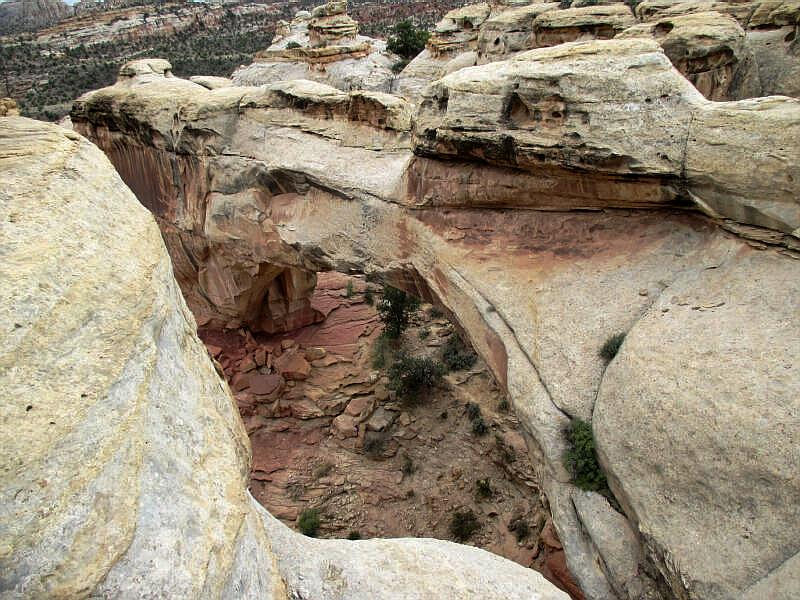 |
History:
THE FATHERS OF CAPITOL REEF NATIONAL PARK
Charles Kelly
History Blazer, September 1995
Two men deserve credit for the
preliminary work that led to the creation of Capitol Reef National Monument (later Park)
— Ephraim P. Pectol and Joseph S. Hickman.
Pectol was born May 16, 1875, in
Glenwood, Sevier County. In 1888 his family moved to Cainesville. In 1910 he bought some
land at Grover and that same year worked in a store in Torrey. He built a lean-to on the
store building and moved to Torrey, purchasing the business and making that town his home
until his death. For three years he taught school while his wife, Dorothy Hickman Pectol,
operated the store.
Pectol was peculiarly blessed with
a love of nature. During the 22 years he lived at Cainesville he frequently passed through
the section now designated as Capitol Reef. To most travelers it was merely a rough
stretch of road, an obstruction to travel, and "a bad place to lose a cow." But
to Pectol it was one of the beauty spots of Utah. Long before it became a national
monument he had named most of its outstanding landmarks, and those names have been
preserved. He originated the name Wayne Wonderland for all of the colorful country lying
between Bicknell and the Colorado River.
Hickman was born at Milford, Utah,
on September 28, 1887, a grandson of the noted pioneer Bill Hickman. When he was eight or
nine years old, the family moved to Cainesville, passing through what was later called
Wayne Wonderland. After returning to Milford for a brief time the Hickman family moved to
Loa, county seat of Wayne County.
His family were cattle ranchers,
but Joe Hickman aspired to become a teacher. He attended the University of Utah, Brigham
Young University, and Utah State Agricultural College, graduating in 1913. On returning to
Wayne County he began teaching school in Torrey. In 1918 he was appointed principal of
Wayne County High School in Bicknell and the next year became county superintendent of
schools.
Hickman was a brother-in-law of
Ephraim P. Pectol who has been called the father of Capitol Reef National Monument. But
the two men worked together to promote the scenic values of Wayne County until Hickman's
life was cut short, leaving Pectol to complete the project.
Hickman and Pectol were almost the
only men in Wayne County who realized the value of the unusual erosional effects and high
color of the cliffs and canyons they called Wayne Wonderland. They were convinced that if
the area could be opened to the public it would attract visitors from all over the nation,
a belief since proved entirely correct.
The first effort to publicize Wayne
Wonderland occurred in 1921 when a Boosters' Club was organized in Torrey with Pectol as
president and Ellis E. Robinson as secretary. Pectol furnished stories and photographs to
any newspaper or magazine that would publish them. In this he was assisted by Hickman.
The Boosters' Club could not
properly publicize Wayne Wonderland, so in 1924-25 Hickman organized the Wayne Wonderland
Club and included groups from other communities. In time this became the Associated Civics
Club of Southern Utah.
In November 1924 Hickman was
elected to the state legislature and immediately introduced a bill to have part of the
Wayne Wonderland designated as a state park. His bill passed and 16 acres in the vicinity
of Fruita, including a large natural bridge (Hickman Bridge), was set aside. Dedication
ceremonies were held in Torrey on July 20, 1925, and Gov. George H. Dern was the principal
speaker. A large sign was erected over the Fremont River bridge west of Torrey reading
"Gateway to Wayne Wonderland." This sign was later moved to Torrey where it
remained for many years.
In the meantime, Hickman had
introduced a resolution in the legislature asking the federal government to consider Wayne
Wonderland as a national monument.
On July 24, only four days after
the celebration in Torrey, Hickman went to Fish Lake with a party of friends. A sudden
storm threw him out of his boat, and unable to swim he drowned.
Pectol continued the work almost
alone for the next ten years. He was elected president of the new Civics Club. At his
suggestion $150 was appropriated for the expenses of Dr. J. E. Broaddus, a well-known
scenic photographer in Salt Lake City, to come to Wayne Wonderland to photograph its
beauties. For several years afterward Broaddus exhibited his photographs and lectured on
Wayne Wonderland. This publicity not only made the area known to the public but eventually
resulted in the creation of Capitol Reef National Monument.
In 1933 Pectol was elected to the
state legislature, and almost his first act was the introduction of a memorial to Congress
asking for the creation of Wayne Wonderland National Monument. During the next four years
he neglected his business to guide federal investigating parties and make a boundary
survey, assisted by Arthur Meeks, Arthur L. Chaffin, and George W. Okerlund.
This great labor of love was
finally rewarded on August 2, 1937, when President Franklin D. Roosevelt signed the
proclamation that created Capitol Reef National Monument in the heart of Wayne Wonderland,
forever setting it aside for the enjoyment of the public. Unfortunately, no funds were
provided to develop and operate it, and not until 1950 was it officially opened to the
public. In 1971 Congress gave Capitol Reef national park status.
Pectol died on October 8, 1947, but
he had lived long enough to see the creation of the monument for which he had worked so
long.
[ Homepage
] [ Introduction ] [ Warning ] [ Ratings
] [ Ethics ] [ Feedback ] [ Updates
]
© Copyright
2000-, Climb-Utah.com |


